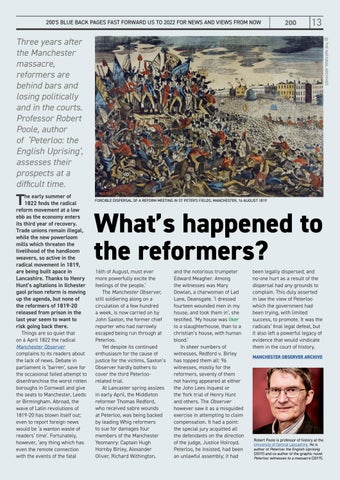200'S BLUE BACK PAGES FAST FORWARD US TO 2022 FOR NEWS AND VIEWS FROM NOW
200
13
T
he early summer of 1822 finds the radical reform movement at a low ebb as the economy enters its third year of recovery. Trade unions remain illegal, while the new powerloom mills which threaten the livelihood of the handloom weavers, so active in the radical movement in 1819, are being built apace in Lancashire. Thanks to Henry Hunt’s agitations in Ilchester gaol prison reform is moving up the agenda, but none of the reformers of 1819-20 released from prison in the last year seem to want to risk going back there.
Things are so quiet that on 6 April 1822 the radical Manchester Observer complains to its readers about the lack of news. Debate in parliament is ‘barren’, save for the occasional failed attempt to disenfranchise the worst rotten boroughs in Cornwall and give the seats to Manchester, Leeds or Birmingham. Abroad, the wave of Latin revolutions of 1819-20 has blown itself out; even to report foreign news would be ‘a wanton waste of readers’ time’. Fortunately, however, ‘any thing which has even the remote connection with the events of the fatal
© THE NATIONAL ARCHIVES
Three years after the Manchester massacre, reformers are behind bars and losing politically and in the courts. Professor Robert Poole, author of ‘Peterloo: the English Uprising’, assesses their prospects at a difficult time. FORCIBLE DISPERSAL OF A REFORM MEETING IN ST PETER'S FIELDS, MANCHESTER, 16 AUGUST 1819
What’s happened to the reformers? 16th of August, must ever more powerfully excite the feelings of the people.’ The Manchester Observer, still soldiering along on a circulation of a few hundred a week, is now carried on by John Saxton, the former chief reporter who had narrowly escaped being run through at Peterloo. Yet despite its continued enthusiasm for the cause of justice for the victims, Saxton’s Observer hardly bothers to cover the third Peterloorelated trial. At Lancaster spring assizes in early April, the Middleton reformer Thomas Redford, who received sabre wounds at Peterloo, was being backed by leading Whig reformers to sue for damages four members of the Manchester Yeomanry: Captain Hugh Hornby Birley, Alexander Oliver, Richard Withington,
and the notorious trumpeter Edward Meagher. Among the witnesses was Mary Dowlan, a charwoman of Lad Lane, Deansgate. ‘I dressed fourteen wounded men in my house, and took them in’, she testified. ‘My house was liker to a slaughterhouse, than to a christian’s house, with human blood.’ In sheer numbers of witnesses, Redford v. Birley has topped them all: 96 witnesses, mostly for the reformers, seventy of them not having appeared at either the John Lees inquest or the York trial of Henry Hunt and others. The Observer however saw it as a misguided exercise in attempting to claim compensation. It had a point: the special jury acquitted all the defendants on the direction of the judge, Justice Holroyd. Peterloo, he insisted, had been an unlawful assembly; it had
been legally dispersed; and no-one hurt as a result of the dispersal had any grounds to complain. This duly asserted in law the view of Peterloo which the government had been trying, with limited success, to promote. It was the radicals’ final legal defeat, but it also left a powerful legacy of evidence that would vindicate them in the court of history. MANCHESTER OBSERVER ARCHIVE
Robert Poole is professor of history at the University of Central Lancashire. He is author of Peterloo: the English Uprising (2019) and co-author of the graphic novel Peterloo: witnesses to a massacre (2019).










